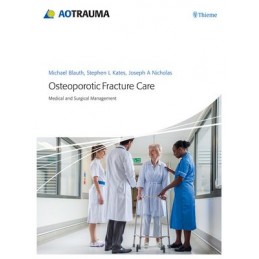- Obniżka


 Dostawa
Dostawa
Wybierz Paczkomat Inpost, Orlen Paczkę, DHL, DPD, Pocztę, email (dla ebooków). Kliknij po więcej
 Płatność
Płatność
Zapłać szybkim przelewem, kartą płatniczą lub za pobraniem. Kliknij po więcej szczegółów
 Zwroty
Zwroty
Jeżeli jesteś konsumentem możesz zwrócić towar w ciągu 14 dni*. Kliknij po więcej szczegółów
With an increase in the longevity of the global population, care of the functional, cognitive, and physical health of older adults is essential. There has been a dramatic demographic shift toward a growing aging population and an increase in osteoporotic fractures that has occurred over the last few decades especially in Western countries. This clearly demonstrates the need for a comprehensive approach to treating fragility fractures by surgeons, geriatricians, and care staff.
Osteoporotic Fracture Care is the first book of its kind to offer a well-rounded and comprehensive resource on fragility fractures and orthogeriatric care designed to help new and experienced surgeons, geriatricians, physicians, and care personnel to better work together and develop interprofessional and interdisciplinary systems so as to treat patients more effectively.
The book contains 44 chapters and is divided into three sections:: Principles, Improving the system of care, and Fracture management. The books key features are::
Opis
Section 1—Principles 1
1.1 Principles of orthogeriatric medical care
1.2 Principles of orthogeriatric surgical care
1.3 Principles of orthogeriatric anesthesia
1.4 Preoperative risk assessment and preparation
1.5 Prognosis and goals of care
1.6 Anticoagulation in the perioperative setting
1.7 Postoperative medical management
1.8 Postoperative surgical management
1.9 Postacute care
1.10 Osteoporosis
1.11 Sarcopenia, malnutrition, frailty, and falls
1.12 Pain management
1.13 Polypharmacy
1.14 Delirium
Section 2—Improving the system of care
2.1 Models of orthogeriatric care
2.2 Overcoming barriers to implementation of a care model
2.3 Clinical practice guidelines
2.4 Elements of an orthogeriatric comanaged program
2.5 Adapting facilities to fragility fracture patients
2.6 Orthogeriatric team-principles, roles, and responsibilities
2.7 Protocol and order set development
2.8 Fracture liaison service and improving treatment rates for osteoporosis
2.9 Use of registry data to improve care
2.10 Lean business principles
Section 3—Fracture management
3.1 Proximal humerus
3.2 Humeral shaft
3.3 Distal humerus
3.4 Elbow
3.5 Olecranon
3.6 Distal forearm
3.7 Pelvic ring
3.8 Acetabulum
3.9 Femoral neck
3.10 Trochanteric and subtrochanteric femur
3.11 Femoral shaft
3.12 Distal femur
3.13 Periprosthetic fractures around the hip
3.14 Periprosthetic fractures around the knee
3.15 Proximal tibia
3.16 Tibial shaft
3.17 Ankle
3.18 Atypical fractures
3.19 Chest trauma
3.20 Polytrauma
